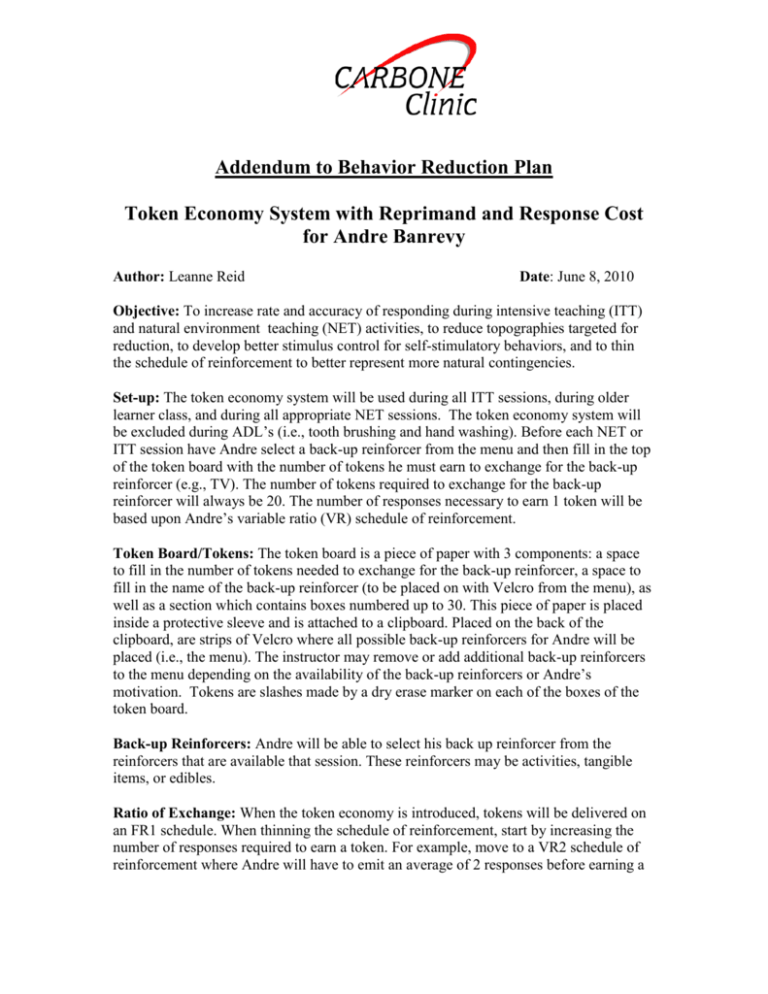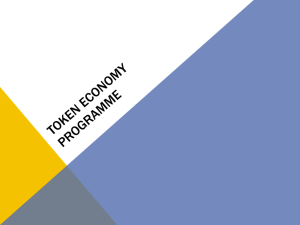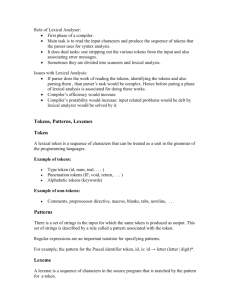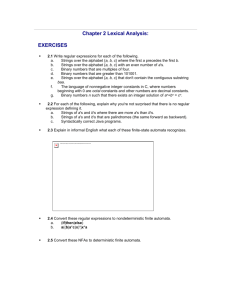
Addendum to Behavior Reduction Plan
Token Economy System with Reprimand and Response Cost
for Andre Banrevy
Author: Leanne Reid
Date: June 8, 2010
Objective: To increase rate and accuracy of responding during intensive teaching (ITT)
and natural environment teaching (NET) activities, to reduce topographies targeted for
reduction, to develop better stimulus control for self-stimulatory behaviors, and to thin
the schedule of reinforcement to better represent more natural contingencies.
Set-up: The token economy system will be used during all ITT sessions, during older
learner class, and during all appropriate NET sessions. The token economy system will
be excluded during ADL’s (i.e., tooth brushing and hand washing). Before each NET or
ITT session have Andre select a back-up reinforcer from the menu and then fill in the top
of the token board with the number of tokens he must earn to exchange for the back-up
reinforcer (e.g., TV). The number of tokens required to exchange for the back-up
reinforcer will always be 20. The number of responses necessary to earn 1 token will be
based upon Andre’s variable ratio (VR) schedule of reinforcement.
Token Board/Tokens: The token board is a piece of paper with 3 components: a space
to fill in the number of tokens needed to exchange for the back-up reinforcer, a space to
fill in the name of the back-up reinforcer (to be placed on with Velcro from the menu), as
well as a section which contains boxes numbered up to 30. This piece of paper is placed
inside a protective sleeve and is attached to a clipboard. Placed on the back of the
clipboard, are strips of Velcro where all possible back-up reinforcers for Andre will be
placed (i.e., the menu). The instructor may remove or add additional back-up reinforcers
to the menu depending on the availability of the back-up reinforcers or Andre’s
motivation. Tokens are slashes made by a dry erase marker on each of the boxes of the
token board.
Back-up Reinforcers: Andre will be able to select his back up reinforcer from the
reinforcers that are available that session. These reinforcers may be activities, tangible
items, or edibles.
Ratio of Exchange: When the token economy is introduced, tokens will be delivered on
an FR1 schedule. When thinning the schedule of reinforcement, start by increasing the
number of responses required to earn a token. For example, move to a VR2 schedule of
reinforcement where Andre will have to emit an average of 2 responses before earning a
token, then continue to thin the schedule of reinforcement by moving to a VR3 schedule
of reinforcement, etc.
To begin with, have Andre working for 20 tokens, with a VR3 for token delivery.
Decisions to thin the schedule of reinforcement will be based upon daily analysis of
problem behavior data and stability in low levels of problem behavior.
Procedures of Implementing the Token Economy:
Set up: When beginning an ITT or NET session with Andre, the instructor
will set the token board on the table or in a location which is visible to
Andre and will direct him to look at the token board. The instructor will
then present him with the opportunity to select a reinforcer to work for by
asking him what he wants to work for or directing him to read his menu
(e.g., “what do you want to work for?” or “Pick out something you want to
work for”). Once a reinforcer is chosen, the instructor will set the criteria
for tokens based upon Andre’s VR. The number of tokens necessary and
the name of the back-up reinforcer will be written on the token board and
the final amount of tokens needed will be circled from the field of
numbers on the token board. Once Andre’s token board is set-up, the
instructor will state the contingency vocally (e.g., “You need to earn ___
tokens for “selected reinforcer”).
Delivery of tokens – ITT, Older Learner Class, and NET: The
instructor will deliver tokens for appropriate responding based on Andre’s
VR schedule. When delivering a token, statements (e.g., “behaviorspecific”) should be emitted at the same time informing Andre of the
behaviors that earned the token. Differentially reinforce
appropriate/correct responding with social praise, and more tokens (see
below: Delivery of tokens using differential reinforcement). While the
tokens are being delivered, occasionally state how many tokens Andre
needs to exchange for the back-up reinforcer.
During ITT sessions, the instructor will place the token board and marker
in front of Andre. When Andre engages in a response scheduled for
reinforcement (see below), and the instructor is ready to deliver tokens,
the instructor will vocally prompt Andre to deliver his own tokens. When
instructing Andre to deliver a token, behavior specific statements (e.g.,
“great job behavior-specific, give yourself a token”) should be emitted at
the same time informing Andre of the behaviors that earned the token.
When Andre earns the designated number of tokens required to exchange
for the back-up reinforcer, say to Andre “You’ve earned all your tokens,
you earned item,” then present the back-up reinforcer. If the back-up
reinforcer is an activity that is limited to a specified time (e.g., 1 minute of
movie), physically prompt Andre to start his timer and turn off his timer
when it beeps once the time had run out.
Delivery of tokens – ADL’s: During ADL’s (i.e., hand washing, tooth
brushing, and independent work) tokens are not delivered, Andre will earn
tokens at the completion of his ADL stimulus-response chain. Number of
tokens to be delivered will be based upon the independence of his
responses during the chain.
Delivery of tokens using differential reinforcement:
A.) Responses to earn single tokens:
a. Quick, accurate, loud responding during ITT on easy skills
(i.e., previously mastered skills) while sitting still, facing the
teacher with hands folded, and feet flat on the floor.
b. Quick, accurate, loud responding on probes of easier target
skills while sitting still, facing the teacher with hands folded,
and feet flat on the floor.
c. Walking appropriately during transitions with hands at his side
without making any inappropriate movements.
d. Quick, accurate, loud responding during NET.
e. Quick, accurate, loud responding during Older Learner Class.
f. Successful completion of an ADL stimulus-response chain that
required prompting.
B.) Responses to earn multiple tokens:
a. Quick, accurate, loud responding on correct responses of
difficult mastered skills (i.e., previously mastered skills not
consistently maintained, IV multiple responses) while sitting
still, facing the teacher with hands folded, and feet flat on the
floor.
b. Quick, accurate, loud responding on probes of difficult targets
(i.e., current acquisition skills) while sitting still, facing the
teacher with hands folded, and feet flat on the floor.
c. Quick, accurate, loud responding on fluency timings during
ITT sessions while sitting still, facing the teacher with hands
folded, and feet flat on the floor.
d. Quick, accurate, loud responding during Older Learner Class
while sitting still, facing the teacher with hands folded, and feet
flat on the floor.
e. Quick, accurate, loud responding on more effortful responses
during NET activities while sitting still, with feet flat on the
floor.
f. Novel responses.
g. Successful completion of an ADL stimulus-response chain,
with more independent responses that previous sessions or
previous teaching trials.
Procedure for Contingent Effort with Reprimand and Response Cost (implemented
during ITT, NET, Older Learners Class, and ADL’s):
While working for tokens:
While working for tokens, if Andre engages in a topography targeted for
reduction after having already earned one or more tokens, deliver the appropriate
reprimand (e.g., “Don’t do that topography specific”) and implement the
contingent effort procedure (see current behavior reduction procedures for up to
date description). After Andre completes the contingent effort procedure, direct
his attention to the token board, remove one token, and tell him, “Don’t do that
topography specific you lose a token. Don’t do that topography specific, or you
will lose a token, you will lose your iPod, and you will do stand up sit downs. Put
your iPod back in you pocket.”
While working for tokens, when no tokens have been earned yet:
While working for tokens, if Andre engages in a topography targeted for
reduction prior to earning any tokens, simply deliver the verbal reprimand,
implement the contingent effort procedure, represent the reprimand after
completion of contingent effort procedure, and restate the contingency for the
contingent effort procedure (i.e., “Don’t do that topography specific, or you will
lose your iPod, and you will do stand up sit downs. Put your iPod back in you
pocket.”).
While contacting reinforcement:
If Andre engages in a topography targeted for reduction while in reinforcement,
remove access to the reinforcer, deliver the verbal reprimand, implement the
contingent effort procedure, represent the reprimand after completion of
contingent effort procedure, and restate the contingency for the contingent effort
procedure (i.e., “Don’t do that topography specific, or you will lose your iPod,
and you will do stand up sit downs. Put your iPod back in you pocket.”). Then
have him reset his token board and return to the ITT or NET activity; do NOT
return to reinforcement.
The following topographies will receive the contingent effort procedure, with verbal
reprimand and response cost:
1. Flopping (F): either while standing or sitting; falling to the floor (usually
accompanied by laughing and muscle stiffening)
2. Hand Squeezing (HS): When hands are folded (fingers laced together) applying
pressure to one or both hands/fingers.
3. Hitting (H): making forceful contact, or any attempt to do so, with an open or
closed hand to another person or object. (typically during transitions) that is
reinforced through automatic positive reinforcement.
4. Inappropriate Touching: putting pressure against another person’s body using
any part of his body (typically seen as grabbing with hands, pushing with elbows,
or forceful hugging)
5. Jumping (J): extending legs to lift himself off the ground (often repetitive and
forceful)
6. Laughing (L): emission of laughter sounds at high rate in inappropriate context
7. Non-functional vocalizations (NFV): vocal, verbal behavior of any volume or
length that is not functionally relevant to the current activity, including but not
limited to: yelling mands or tacts during transitions (e.g., screaming “chex” while
walking down the hallway), tacting actions or objects during an activity (e.g.,
saying “marker, marker” while coloring), or any other unrelated vocalizations
(e.g., whispering “Barney” while watching the movie Inspector Gadget or yelling
for any reinforcer during class when there is nothing present signaling the
availability of that reinforcer); episodes are distinguished from another episode by
a delay of at least 2 seconds
8. Pinch (P): clenching together of thumb and at least one finger on self (typically
arms or chest) that is reinforced through automatic positive reinforcement.
9. Repetitive Leg Movements: repetitive movement of feet or legs against each
other, other surfaces, or in the air which are not functionally related to present
activity (typically seen as stomping feet on floor, clapping soles of shoes together,
or shaking legs)
10. Repetitive Mands (in class only) (RM): a verbal, vocal mand emitted in the
proximity of an appropriate audience in which the requested
item/action/information is said more than once within a 3 second period.
11. Rocking: repetitive movement of the torso forwards and backwards or side to
side that occurs when sitting or standing and lasts more than 2 seconds (if
standing, typically includes arching the back and then forcefully standing up
straight again)
12. Rubbing eyes (R): pressing any part of fingers or hands against eyes for more
than two seconds that is reinforced through automatic positive reinforcement.
13. Snap: Contact between the thumb and any finger that is followed by a sliding
movement of the finger along the thumb that is typically accompanied by a “pop”
sound when finger contacts the palm. Multiple snaps frequently occur in
succession on either and/or both hands.
14. Stiffening (S): flexing of muscles (typically neck, arms, hands, legs) for more
than two seconds, usually accompanied by straightening and/or extension limbs.
15. Touching Crotch (TC): contact of hand to crotch area, typically with hand inside
pants
Data/Graphing
Data Recording:
Sequence analysis and duration data for all episodes of problem behaviors
throughout the session.
Graphing:
Total frequency of problem behavior per 3-hr. session
Total frequency of episodes of hand squeezes per 3-hr. session
Total frequency and cumulative duration of problem behavior per 3-hr. session
Total frequency of episodes of problem behavior by antecedent per 3-hr. session
o Interruption/denied access
o Demand at table/demand away from table
o Sensory reinforcement/wants something/MO unclear
Total frequency of punishment procedures per 3-hr. session
Total frequency of punishment procedures for hand squeezing per 3-hr. session
Total frequency and cumulative duration of all punishment procedures per 3-hr.
session
Total frequency of non-functional vocalizations per 3-hr. session
References
Cooper, J., Heron, T,. & Heward, W. (2007). Applied Behavior Analysis. New Jersey:
Pearson Prentice Hall.
I need ________ tokens to
earn _________________
1
2
3
4
5
6
7
8
9
10
11
12
13
14
15
16
17
18
19
20
21
22
23
24
25
26
27
28
29
30










